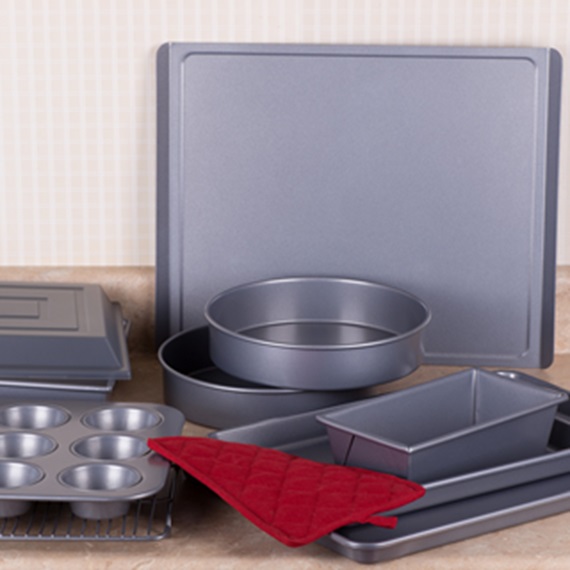The humble baking tray may not be the star of your collection, but it’s one of the most valuable kitchen tools. From roasting vegetables to baking cookies and preparing one-pan meals, baking trays quietly handle an impressive range of tasks with efficiency and consistency. Yet, despite their importance, they’re often overlooked when it comes to investing in quality kitchenware. Let’s break down everything you need to know to buy baking trays that meet your needs.
Different Types of Baking Trays

Whether you’re a seasoned baker or just getting started, understanding the different types of reliable and versatile baking trays and how to choose the right one for each task can elevate your results and save time in the kitchen. Not all trays are created equal. The material of your tray can dramatically impact cooking results and clean-up time.
Carbon Steel
Carbon steel is a favourite among professional bakers for its heat retention and ability to deliver deeply browned, crispy crusts. These baking trays for sale are heavier and often have a dark surface that enhances browning. However, they require a bit of maintenance and can rust if not properly dried and stored. The trade-off is exceptional results for items like pizza, focaccia or crispier bakes.
Stainless Steel
If you’re looking for something durable and long-lasting, stainless steel trays are a great choice. They’re non-reactive, rust-resistant, and can take a beating in high-heat applications. However, stainless steel doesn’t conduct heat as well as aluminium, which means you might get less even browning unless you compensate by adjusting cook times or temperatures. They’re also a bit heavier and pricier, but if you roast meat or do high-heat cooking often, stainless steel pays off over time. Stainless steel trays are best for roasting meats and veggies, high-temperature cooking, and frequent use.
Aluminium and Aluminised Steel
Aluminium trays are widely popular for good reason. They’re lightweight, affordable, and conduct heat extremely well, which leads to evenly baked cookies and perfectly roasted vegetables. Aluminised steel is a variation coated for extra durability and resistance to rust.
These trays are excellent for general-purpose baking, but pure aluminium can be reactive with acidic foods like tomatoes or citrus, and thinner ones may warp at high temperatures. Still, they remain a go-to choice for everything from pastries to sheet pan dinners. These trays are best for making cookies, pastries, roasting vegetables, and everyday baking.
Non-Stick Coated Trays
These trays combine aluminium or steel with a non-stick coating. They’re perfect for sticky or delicate baked goods and make clean-up a breeze. The downside? That coating can degrade over time, especially if exposed to metal utensils or very high heat. They’re convenient, but not ideal for crisping or deep browning due to the insulating nature of the coating. Best suitable for making cakes, cookies and baked goods prone to sticking.
Silicone Mats and Liners
Technically not a tray themselves, silicone mats are a non-stick, reusable liners that pair well with any baking tray. They offer excellent release for delicate items and make clean-up almost too easy. Just keep in mind that they don’t conduct heat, which can lead to paler bottoms if browning is a goal. They’re also not ideal for crispy recipes. However, they are great for baking cookies, macarons, sticky candies, and delicate pastries.
Understanding the Basics

At its core, a baking tray is a flat, rectangular metal pan with low sides, used for baking or roasting. But several small details can make a big difference in performance:
- Rimmed or Rimless: Rimmed trays help contain juices from roasted vegetables or meats, making them ideal for messy or moist dishes. Rimless trays, on the other hand, make it easy to slide cookies off without disturbing their shape.
- Material Matters: As outlined above, each metal reacts to heat and food differently. Take into consideration how often you bake and what you usually cook.
- Gauge and Thickness: Thicker trays are less likely to warp and provide more even heat distribution. Thin trays are cheaper but often result in uneven cooking and bending at high temperatures. Choosing wisely leads to better baking results, easier clean-up, and trays that last years rather than months.
Choosing the Right Tray for the Task
When you’re ready to buy baking trays, think about what you cook most often, and invest in a few versatile pieces instead of one-size-fits-all solutions. For different foods like:
- Cookies: Go for aluminised steel or non-stick aluminium. They heat evenly and release cookies cleanly. Pair with a silicone mat for delicate varieties like macarons.
- Roasting Veggies and Sheet Pan Dinners: Choose a rimmed aluminium or stainless steel tray to handle moisture and ensure even roasting without spilling.
- Fries and Crispy Items: A dark, heavy-gauge aluminium or carbon steel tray works best. Perforated trays are excellent for maximising air circulation and crisping.
- Bread and Rolls: This depends on your desired outcome. Use carbon steel for a deep crust, or aluminium for softer bakes. Glass is sometimes used but heats differently and less evenly than metal.
- Pizza: A carbon steel tray or dedicated pizza pan will help you achieve that sought-after crispy bottom crust.
The Bottom Line
The baking trays may not be glamorous, but they’re undeniably one of the most essential tools in your kitchen. Understanding the materials, design features, and appropriate uses of different trays can help you achieve better cooking and baking results with less effort and more consistency.
Whether you’re roasting vegetables for a weeknight dinner or baking a batch of cookies for the holidays, the right tray makes all the difference. With so many trays for sale today, it’s easier than ever to find quality options that suit your cooking style. So, next time you shop for a tray online, skip the cheapest option and choose one that delivers performance, durability, and delicious results for years to come.


